Airlines, Airports and Airliners 11 to 18 January 2023
Compiled by Willie Bodenstein
Google Banner Ad
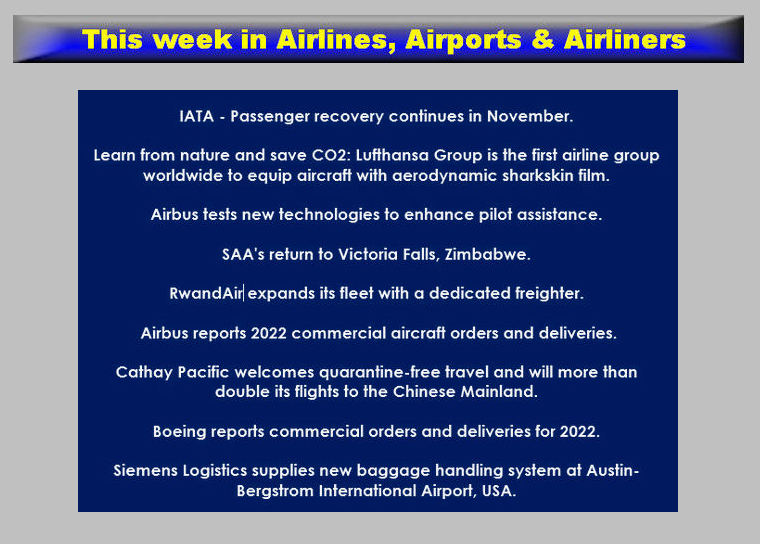
IATA - PASSENGER RECOVERY CONTINUES IN NOVEMBER.

The International Air Transport Association (IATA) announced that the air travel recovery continued through November 2022.
Total traffic in November 2022 (measured in revenue passenger kilometres or RPKs) rose 41.3% compared to November 2021. Globally, traffic is now at 75.3% of November 2019 levels.
International traffic rose 85.2% versus November 2021. The Asia-Pacific continued to report the strongest year-over-year results with all regions showing improvement compared to the prior year. November 2022 international RPKs reached 73.7% of November 2019 levels. Domestic traffic for November 2022 was up 3.4% compared to November 2021 with travel restrictions in China continuing to dampen the global result. Total November 2022 domestic traffic was at 77.7% of the November 2019 level.
"Traffic results in November reinforce that consumers are thoroughly enjoying the freedom to travel. Unfortunately, the reactions to China's reopening of international travel in January reminds us that many governments are still playing science politics when it comes to COVID-19 and travel. Epidemiologists, the European Centre for Disease Prevention and Control and others have said that the reintroduction of testing for travellers from China can do little to contain a virus that is already present around the world. And China's objections to these policy measures are compromised by their own pre-departure testing requirements for people traveling to China. Governments should focus on using available tools to manage COVID-19 effectively-including improved therapeutics and vaccinations-rather than repeating policies that have failed time and again over the last three years," said Willie Walsh, IATA's Director General.
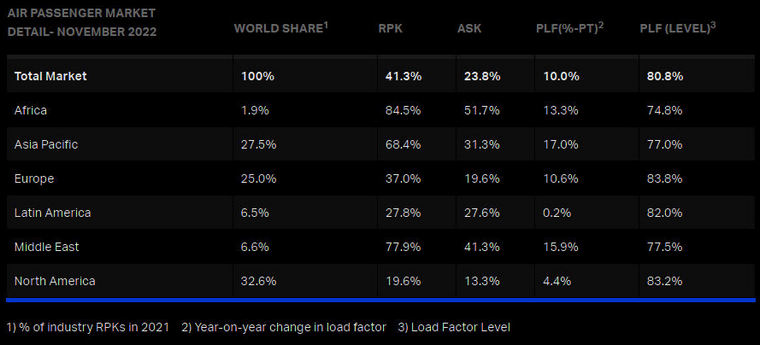
International Passenger Markets
Asia-Pacific airlines had a 373.9% rise in November traffic compared to November 2021, which was the strongest year-over-year rate among the regions. Capacity rose 159.2% and the load factor was up 35.9 percentage points to 79.2%.
European carriers' November traffic climbed 45.3% versus November 2021. Capacity increased 25.1%, and load factor moved up 11.6 percentage points to 83.6%, highest among the regions.
Middle Eastern airlines saw an 84.6% traffic rise in November compared to November 2021. November capacity increased 45.4% versus the year-ago period, and load factor climbed 16.5 percentage points to 77.7%.
North American carriers experienced a 69.9% traffic rise in November versus the 2021 period. Capacity increased 45.5%, and load factor climbed 11.6 percentage points to 81.0%.
Latin American airlines' November traffic rose 59.2% compared to the same month in 2021. November capacity climbed 55.6% and load factor increased 1.9 percentage points to 82.9%.
African airlines had an 83.5% rise in November RPKs versus a year ago. November 2022 capacity was up 48.4% and load factor climbed 14.2 percentage points to 74.3%, the lowest among regions.
Domestic Passenger Markets
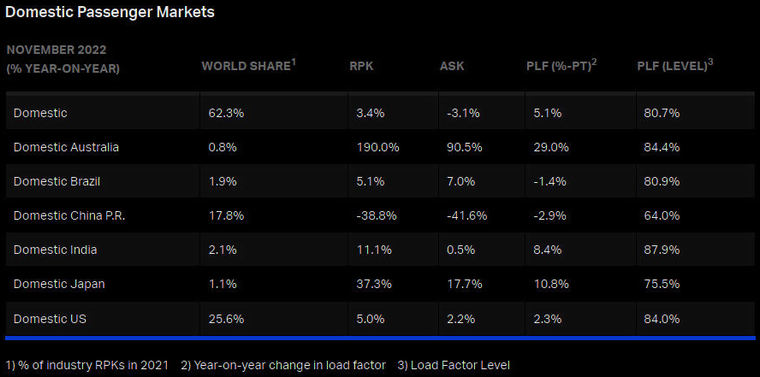
Brazil's domestic RPKs rose 5.1% in November compared to November 2021 and are now at 96.2% of 2019 levels.
US domestic traffic climbed 5.0% in November compared to November 2021, pushing it to 99% of the November 2019 level.

Google Banner Ad
LEARN FROM NATURE AND SAVE CO2: LUFTHANSA GROUP IS THE FIRST AIRLINE GROUP WORLDWIDE TO EQUIP AIRCRAFT WITH AERODYNAMIC SHARKSKIN FILM
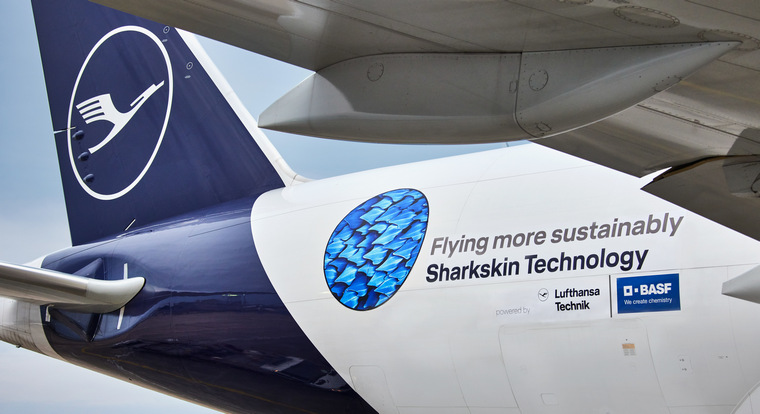
Following nature's example, Lufthansa Technik and BASF have jointly developed the functional surface film AeroSHARK for commercial aircraft. The film is modelled on the microscopic structure of shark skin and is applied to the aircraft's outer skin. It directly reduces aircraft drag, cuts kerosene consumption and thus CO2 emissions. The Lufthansa Group will be the first airline group in the world to equip more than 20 long-haul aircraft in its fleet with aerodynamic sharkskin film.
Following extensive testing and a certification process lasting several months, the European Union Aviation Safety Agency (EASA) has now granted Lufthansa Technik a Supplemental Type Certificate (STC) for the series application of this technology on two Boeing 777 models.
In the future, all twelve long-haul B777-300ER aircraft at SWISS will fly with the fuel-saving surface technology. The same applies to Lufthansa Cargo's current fleet of eleven Boeing 777F freighters. The first SWISS aircraft equipped with AeroSHARK (registration HB-JNH) has already been in scheduled service since October. This aircraft had also completed the flight test program for the certification it has now received. In January 2023, the next Boeing 777 aircraft in Frankfurt and Zurich are scheduled to be modified with the riblet films.
"For a more sustainable future in aviation, we are consistently driving change in our industry. Our ambitious goal: a neutral CO2 balance by 2050. Already by 2030, we want to halve our net CO2 emissions compared to 2019. AeroSHARK surface technology developed by Lufthansa Technik together with BASF, we are once again underlining our innovation leadership. We are the first airline group worldwide to use this new technology," said Christina Foerster, Member of the Lufthansa Group's Executive Board, responsible for Brand and Sustainability. "By covering more than 20 aircraft with the new sharkskin film, we will reduce the Lufthansa Group's CO2 footprint by more than 25,000 tons annually."
The fuel-saving AeroSHARK film
AeroSHARK consists of millions of ribs around 50 micrometres in size, known as riblets. They imitate the properties of sharkskin and thus optimize aerodynamics at flow-relevant points of the aircraft such as the fuselage or the engine nacelles. As a result, less fuel is required. By covering 950 square meters of a Boeing 777-300ER's outer skin, for example, annual savings of around 400 tons of kerosene and more than 1,200 tons of CO2 can be achieved.
Google Banner Ad
AIRBUS TESTS NEW TECHNOLOGIES TO ENHANCE PILOT ASSISTANCE
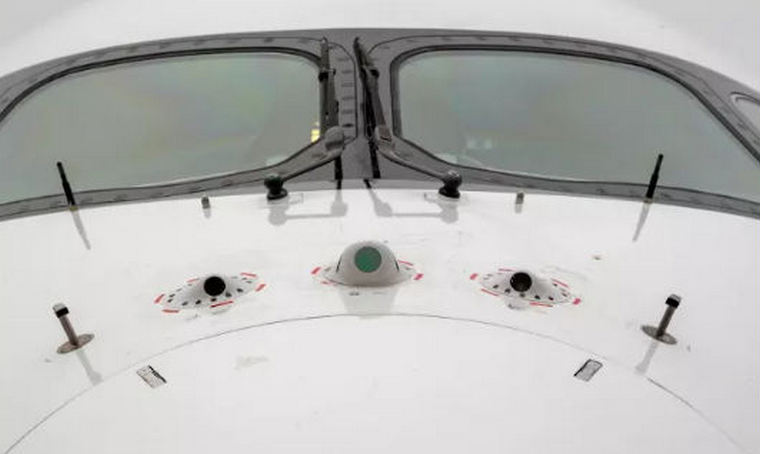
Airbus UpNext, a wholly owned subsidiary of Airbus, has started testing new, on ground and in-flight, pilot assistance technologies on an A350-1000 test aircraft.
Known as DragonFly, the technologies being demonstrated include automated emergency diversion in cruise, automatic landing and taxi assistance and are aimed at evaluating the feasibility and pertinence of further exploring autonomous flight systems in support of safer and more efficient operations.
"These tests are one of several steps in the methodical research of technologies to further enhance operations and improve safety," said Isabelle Lacaze, Head of DragonFly demonstrator, Airbus UpNext. "Inspired by biomimicry, the systems being tested have been designed to identify features in the landscape that enable an aircraft to "see" and safely manoeuvre autonomously within its surroundings, in the same way that dragonflies are known to have the ability to recognise landmarks."
During the flight test campaign, the technologies were able to assist pilots in-flight, managing a simulated incapacitated crew member event and during landing and taxiing operations. Taking into account external factors such as flight zones, terrain and weather conditions, the aircraft was able to generate a new flight trajectory plan and communicate with both Air Traffic Control (ATC) and the airline Operations Control Centre.
Airbus UpNext has also explored features for taxi assistance, which were tested in real-time conditions at Toulouse-Blagnac Airport. The technology provides the crew with audio alerts in reaction to obstacles, assisted speed control and guidance to the runway using a dedicated airport map.
In addition to these capabilities, Airbus UpNext is launching a project to prepare the next generation of computer vision-based algorithms to advance landing and taxi assistance.
These tests were made possible through cooperation with Airbus subsidiaries and external partners including Cobham, Collins Aerospace, Honeywell, Onera and Thales. DragonFly was partially funded by the French Civil Aviation Authority (DGAC) as part of the French Stimulus plan, which is part of the European Plan, Next Generation EU and the France 2030 plan.
Google Banner Ad
SAA'S RETURN TO VICTORIA FALLS, ZIMBABWE

South African Airways (SAA) marked its relaunch to Victoria Falls in Zimbabwe on 14th December 2022. The airline first commenced services to Victoria Falls in the year 2000 and returning to this route, the seventh wonder of the world was met with much excitement, celebration and ceremonial gesticulation by the community, stakeholders as well as government of Zimbabwe.
Various dignitaries graced the opening event held at Victoria Falls International Airport including the Deputy Minister of Transport and Infrastructure Development, Acting Mayor of Victoria Falls, Resident Minister, President of the Tourism Business Council, CEO of Airports Company Zimbabwe, CEO of Zimbabwe Tourism Authority and other government officials. The relaunch of the route was seen by various speakers as an important milestone and significant contribution by SAA towards the development of the region and the continent in terms of improving economy, tourism and job creation.
Deputy Minister of Transport and Infrastructure Development, Honourable Mr. Mike Madiro expressed gratitude to the SAA Board, Management and employees for returning to Victoria Falls. Honourable Madiro said, 'Air transportation serves as a pivotal economic driver and SAA has become a key player connecting South Africa and Zimbabwe, he added, "SAA is bringing the world to Victoria Falls and taking Victoria Falls to the World."
Other key stakeholders at the inaugural ceremony at Victoria Falls International Airport agreed that connecting people for business and leisure is key to economic growth, building relationships and the development of Zimbabwe.
SAA representative at the launch event, Board Member and Chief Financial Officer, Mr Fikile Mhlontlo said, "When the airline commenced operations one of the countries SAA restarted in September 2021 with was Zimbabwe flying from Johannesburg to Harare, so relaunching Victoria Falls signals the airlines strategic intent of serving neighbouring countries including the wonderful Zimbabwe. SAA is committed in the medium to long-term easing connectivity challenges on the African continent. We are thankful and it is really heartening that SAA is seen as the national carrier of many countries in Africa. May Africa grow from strength to strength".
SAA Executive Chairperson and CEO, Prof. John Lamola says, "SAA had been through an unprecedented time in its history with financial challenges culminating in the business rescue and difficulties associated with Covid19 leading to ceasing of flight operations. SAA is back and is very pleased with the positive support it is receiving from passengers and all stakeholders who wish the airline well."
SAA flies to Victoria Falls six days a week. Victoria Falls remains a popular tourist destination and the airline is proud to take its customers to the magnificence of one of the World's largest waterfalls.
Google Banner Ad
RWANDAIR EXPANDS ITS FLEET WITH A DEDICATED FREIGHTER.

RwandAir has today taken delivery of its first dedicated cargo aircraft as the carrier expands its fleet. The Boeing 737-800 SF, which is painted in RwandAir's first cargo livery, will be based at the carrier's Kigali hub. The new jet will allow the Rwandan carrier to further expand its cargo operation, which has been on the rise.
RwandAir will operate the new freighter to a number of key destinations in Africa and the Middle East, including Johannesburg, Nairobi and UAE.
Yvonne Makolo, CEO of RwandAir said: "The delivery of our dedicated cargo aircraft is a huge milestone in RwandAir's fleet expansion plans. Cargo is of ever-increasing importance for the aviation industry and as a landlocked country, we recognize the importance and value of good cargo connections."
"We want to ensure that Africa is seamlessly connected to the world, driving economic growth and valuable trade deals."
From its hub at the heart of Africa at Kigali International Airport, RwandAir is renowned for its excellent customer service where recently RwandAir won the award for 'Best Airline Staff in Africa' at Skytrax's 2022 World Airline Awards, for a second successive year.
RwandAir currently operates to a variety of destinations across East, Central, West, and Southern Africa, the Middle East, Europe, and Asia.
Google Banner Ad
AIRBUS REPORTS 2022 COMMERCIAL AIRCRAFT ORDERS AND DELIVERIES

Airbus SE delivered 661* commercial aircraft to 84 customers in 2022 and registered 1,078 gross new orders. Airbus' end December 2022 backlog stood at 7,239 aircraft.
"In 2022 we served 84 customers with 661 deliveries, an increase of 8 percent compared to 2021. That's obviously less than we were targeting but given the complexity of the operating environment I want to thank the teams and our partners for the hard work and the ultimate result," said Guillaume Faury, Airbus Chief Executive Officer. "The significant order intake covering all our aircraft families including freighters, reflects the strength and competitiveness of our product line. We continue our ramp-up trajectory to deliver on our backlog."
In 2022, deliveries included:
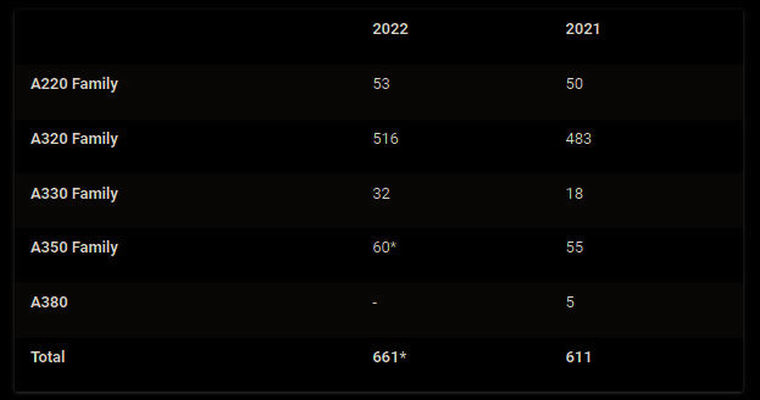
After a reduction of two aircraft (2 A350-900 AEROFLOT) previously recorded as sold in December 2021 for which a transfer was not possible due to international sanctions against Russia.
Airbus equally won 1,078 new orders (820 net) across all programmes and market segments, including several high-profile commitments from some of the world's leading carriers. In aircraft units, Airbus recorded a net book to bill ratio significantly above one.
Per programme, the A220 won 127 firm gross new orders. The A320neo Family won 888 gross new orders. In the widebody segment, Airbus won 63 gross new orders including 19 A330s and 44 A350s of which 24 were for the newly launched A350F.
Google Banner Ad
CATHAY PACIFIC WELCOMES QUARANTINE-FREE TRAVEL AND WILL MORE THAN DOUBLE ITS FLIGHTS TO THE CHINESE MAINLAND
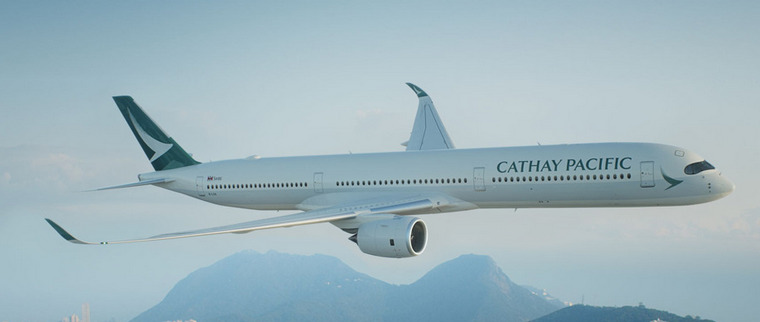
Cathay Pacific welcomes the Hong Kong SAR Government's latest measures to facilitate quarantine-free travel between Hong Kong and the Chinese Mainland, as well as the lifting of transit restrictions, effective 8 January 2023.
In light of today's announcement, Cathay Pacific will more than double its flights into the Chinese Mainland, operating 61 return flights per week between Hong Kong and 13 Mainland cities from 14 January 2023. This compares to the 27 flights per week from Hong Kong to the Mainland and 50 flights per week from the Mainland to Hong Kong that the airline is currently operating.
Cathay Pacific is working actively to resume and add more flights progressively between Hong Kong and the Chinese Mainland in the coming weeks, with the aim of operating over 100 return flights per week by March 2023.
From 8 January 2023, Cathay Pacific will increase its flights between Hong Kong and Beijing to 10 pairs per week and between Hong Kong and Shanghai (Pudong) to 21 pairs per week. The airline is also resuming flights to Guangzhou with five return flights per week.
Meanwhile, from 14 January 2023 the airline will increase its flights between Hong Kong and Xiamen to four pairs per week and between Hong Kong and Chengdu to six pairs per week.
As of today, Cathay Pacific operates flights serving close to 60 destinations worldwide. The airline continues to add more destinations to its schedule. Please visit our website for the latest flight schedule and information.
The Group remains fully committed to rebuilding the connectivity of the Hong Kong international aviation hub. As a Group, we anticipate that we will be operating around 70% of pre-pandemic passenger flight capacity by the end of 2023, with an aim to return to pre-pandemic levels by the end of 2024.
Google Banner Ad
BOEING REPORTS COMMERCIAL ORDERS AND DELIVERIES FOR 2022
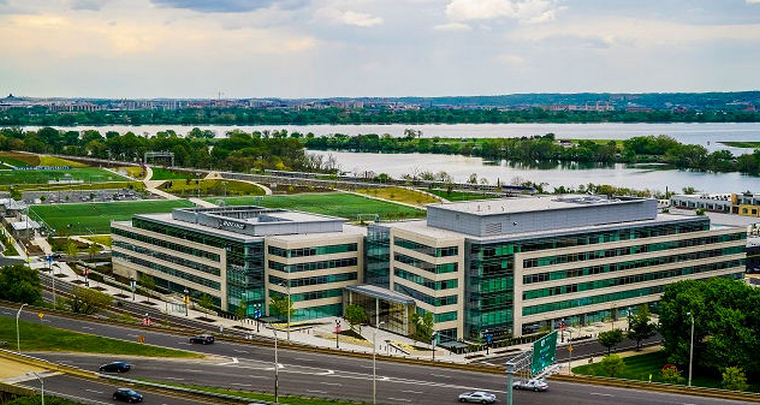
Boeing [NYSE: BA] reported 774 commercial orders last year after cancellations and conversions, including 561 orders for the 737 family and 213 orders for the company's market-leading twin-aisle airplanes. Boeing delivered 69 commercial jets in December, including 53 737 MAX, bringing total deliveries for 2022 to 480 airplanes.
"We worked hard in 2022 to stabilize 737 production, resume 787 deliveries, launch the 777-8 Freighter and most importantly, meet our customer commitments," said Boeing Commercial Airplanes President and CEO Stan Deal. "As the airline industry expands its recovery, we are seeing strong demand across our product family, particularly the highly efficient 737 MAX and the 787 Dreamliner. We will stay focused on driving stability within our operations and the supply chain as we work to deliver for our customers in 2023 and beyond."
Commercial orders after cancellations and conversions include:
561 orders for the 737 MAX, adding new customers such as ANA, Delta Air Lines, IAG and low-cost carrier Arajet
213 orders for widebodies, including 114 787s, 31 767s and 68 777s
78 orders across Boeing's freighter line, including 45 orders for the 767-300 Freighter and current 777 Freighter
Launching the 777-8 Freighter with more than 50 orders, including conversions, for the market's most capable freighter
Commercial deliveries include:
387 737s, including 374 737 MAX and 13 military-derivative airplanes
93 widebodies, including 5 747s, 33 767s, 24 777s and 31 787s
44 new production freighters
As of Dec. 31, 2022, the Commercial Airplanes backlog is 4,578 jets.
A detailed breakdown of 2022 commercial airplane orders and deliveries is available on Boeing's Orders and Deliveries website.
Google Banner Ad
SIEMENS LOGISTICS SUPPLIES NEW BAGGAGE HANDLING SYSTEM AT AUSTIN-BERGSTROM INTERNATIONAL AIRPORT, USA
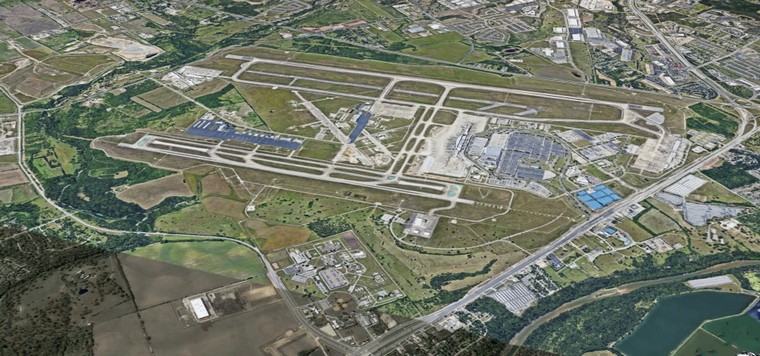
Siemens Logistics will soon begin installation of the new outbound baggage handling system (BHS) at Austin-Bergstrom International Airport, Texas, USA. After processing outbound passenger bags for over twenty years, the existing BHS will be replaced by Siemens to meet today's industry standards. For this, the company will supply a new mainline belt conveyor, sortation via high-speed diverters and vertical sorters. The scope of the order also includes the modernization of the higher and lower-level controls for the entire system. The measures are scheduled for completion by late 2024.
"It makes us very proud that Austin-Bergstrom International Airport has once again chosen us as its partner for this project," said Michael Schneider, CEO of Siemens Logistics. "With our forward-looking sorting and conveying technologies and our experienced team, we help the customer to further improve baggage handling processes at its airport."
The current works represent a collaborative continuation of Siemens Logistics' journey with Austin-Bergstrom International Airport (AUS), as the system being replaced is the original Siemens BHS installed in the late 90s.
"This is an important project and a key improvement that will provide benefits for us in the near-term and for future generations of AUS travellers," explained Somer Shindler, Chief Development Officer at Austin-Bergstrom International Airport. "Our airport is serving more passengers and processing more bags than ever before. We are thrilled to work with the exceptional and renowned team from Siemens Logistics once again to bring this new and improved system to our airport."
"Our goal is to supply solutions and systems that exceed our customer's needs. We look forward to working collaboratively with our partners and customer to deliver a baggage handling system that becomes a true asset to the airport operations at Austin-Bergstrom International Airport for decades to come," stated Andrew Savage, CEO of Siemens Logistics in the United States.
Siemens Logistics will be tasked with the provision and installation of more than 2.4 kilometres (1.5 miles) of belt conveyor with over 900 drives. The system will feature a new consolidated Checked Baggage Inspection System with seven latest generation screening machines. They are expected to screen baggage at a total capacity of 4,000 items per hour. This is a necessary goal taking into account Austin's escalating growth rate. To meet this new capacity requirement, Siemens will oversee the full controls upgrading of the system - underlined by a refreshed higher level control architecture and modern, networked lower-level controls.
Google Banner Ad

|
                      |























